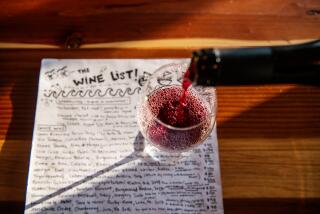Whatâs Red and Hyped and Sells All Over?
NAPA â The most widely available red wine in the world, Gallo Hearty Burgundy, is suddenly in such great demand that itâs being carefully parceled out.
In fact, supermarket sales of all red wine rose 44% from Nov. 17 through Dec. 15 over the same period a year ago. And tasting room managers report that in the last three months there has been enormous interest in red wines, more than at any other time in American history.
Why are Americans suddenly going nuts for red wine?
It is all linked to a Nov. 17 report on â60 Minutes.â Doctors interviewed for the segment called âThe French Paradoxâ attributed the low rates of heart disease among the French, whose diet is high in fat, partly to their high consumption of red wine.
Really, this is nothing new. Scientific studies dating back 20 years have repeatedly shown that regular, moderate consumption of alcohol (two drinks a day) helps lower the risk of heart disease by as much as 50%. Much of this material has been buried in the medical literature, unseen by the general public, and most doctors seem reluctant to recommend wine for fear that some may overconsume and become alcoholics.
In recent months, new findings have attributed even greater protective benefits to wine, red wine in particular, and some research reports linking moderate alcohol use and lower heart disease have made their way into popular magazines and newspapers. The substance of the â60 Minutesâ report had already appeared in an In Health magazine article by Edward Dolnick that was reprinted in The Times Food section.
When â60 Minutesâ told the story, though, the public reaction was huge.
* Pat McLaughlin, a Reno-area Gallo distributor, says the day after the broadcast he was flooded with orders for Galloâs Hearty Burgundy, and by mid-February, he was completely out of 1.5-liter bottles of the wine and was selling the 750-milliliter bottles only on tight allocation.
* The day after the report aired, sales of red wine to American Airlines passengers increased so dramatically, says Richard Vine, wine consultant to the airline, that on most flights they simply couldnât carry enough red wine. At the same time, sales of white wine decreased.
* An in-house memo at the Robert Mondavi Winery quoted an Atlanta wine merchant as saying, âEveryone over 50 came in and bought a case of red wine on Monday morning!â
* Winemaker Mike Martini at the Louis Martini winery says sales of all his red wines were up, âand Merlot is off the charts.â
* The San Francisco-based trade organizations American Wine Alliance for Research and Education and Wine Institute have been inundated with requests for transcripts of the show.
* Shops throughout the country report increased red wine sales immediately after the show, many to people who had never drunk any wine at all. Even longtime wine drinkers are taking note. âOne of my regular customers came in and said, âIâm here for my health food,â â says David Russell, wine buyer for the Wine Cask in Santa Barbara.
* Print advertisements began appearing indicating that you could lower the risk of heart disease by consuming French red wine. The ads, which appeared in early December, were taken out by the French trade group Food and Wines from France, based in New York. They implied that the benefits mentioned by â60 Minutesâ were specific to French wine. On Dec. 19, the Federal Trade Commission began an investigation of the ads to determine if they represented âunfair or deceptive acts or practicesâ that violate FTC regulations.
In the report, Morley Safer noted that the French eat large amounts of fat (liver pate, cheese, butter, eggs), they smoke heavily and they exercise less than Americans, yet they have less than half the rate of heart disease. Safer said the paradox may be explained by a number of key differences in the diets of Americans and Frenchmen.
One issue was the difference between eating whole milk and cheese. Dr. Serge Reynaud, a public health physician from Lyon, told Safer that the fat in naturally fermented cheese combines with calcium and is excreted. But the fat in whole milk is absorbed by the body.
Safer said the French eat 40 pounds of cheese per year, on average (along with 17 pounds of butter and four pounds of lard). Americans eat 17 pounds of cheese, four pounds of butter and two pounds of lard per year.
Other differences between the American and French diets were the duration of meals (the French eat more slowly; Americans eat fast food on the run), the French habit of not snacking between meals, and the freshness of the foods in the French diet, compared with the processed nature of much U.S. food.
But a key point made on the show was that the one major difference between the diets was wine. The French consume about 20 gallons of wine per person per year--about a quarter of a bottle a day. Americans consume less than two gallons per person per year, about a half-ounce a day.
Moreover, industry analysts say U.S. wine consumption is dropping (from 2.4 gallons per capita in 1987) because of pressure from groups intent on reducing drunken driving and concern for alcoholism.
Dr. R. Curtis Ellison, chief of preventive medicine and epidemiology at Boston University School of Medicine, was interviewed on â60 Minutes.â Last Tuesday, speaking to the board of directors of the Wine Institute, Ellison showed charts and graphs indicating a lowered risk of heart disease âthrough regular consumption of alcohol with meals, especially red wine.â He added that âperiodic consumption is less protective.â
Ellison is one of the few doctors willing to go on record regarding the healthful benefits of moderate consumption of wine. âI think as physicians we are all very much aware of the tremendous problems of alcohol abuse,â he said in a recent interview, â. . . and we even know that from the heart point of view, if you have your three bottles of wine all on a Saturday night, itâs very bad for your platelets, itâs very bad for your coronaries, itâs bad for your health in general, as well as the health of others if you happen to be driving.
âOn the other hand, if you spread out your three bottles, and have half a bottle every day with your meal, over several hours, it may well be that you are protecting the heart by decreasing the stickiness of your platelets.â
On the â60 Minutesâ segment, Safer said: âA number of American doctors, none of whom would go on record, told me that if it was up to them, they would get rid of milk in school lunchrooms and exchange it for watered wine. The American milk habit, they said, is priming our 12-year-olds for heart attacks at 50.â
âThe vast majority of people in the world do not drink milk after infancy,â said Ellison. âMilk is good for calcium, but itâs bad for fat. Whole milk especially is very bad. If you drink milk, make it skim milk.â
Ellison also noted that âthe earlier they (children) are exposed to (wine), the less they abuse it later in life.â He spoke of a Boston-area study that showed that Irish families prohibit alcohol until the legal drinking age and Italian families serve watered-down wine to children. He said the rate of alcoholism of Irish families in the Boston area is significantly higher than the rate of Italian families.
The Wine Institute has arranged for Ellison to make a four-city tour (to San Francisco, Los Angeles, New York and Washington), where he will repeat his opinions on wine to the media. Ellison is also seeking a $5-million grant from the National Institutes for Health to research the effects of wine on the body.
Meanwhile, wineries are prohibited by federal regulation from making any claims about the health benefits of wine. A policy statement from the Bureau of Alcohol, Tobacco and Firearms, which regulates wine, contains this paragraph:
â . . . we hold that all therapeutic claims regardless of their truthfulness (are) inherently misleading and particularly deceptive in view of the possible social effect of encouraging the consumption of alcoholic beverages by those who for psychological or physical reasons are adversely affected thereby.â The statement concludes that wine â(is) not a medicine of any sort.â
Wine Institute acknowledges that wine is not a medicine, but said it may have preventive powers and it plans to discuss the policy statement with BATF, hoping to have it modified or eliminated.
More to Read
Eat your way across L.A.
Get our weekly Tasting Notes newsletter for reviews, news and more.
You may occasionally receive promotional content from the Los Angeles Times.










